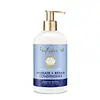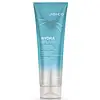What's inside
What's inside
 Key Ingredients
Key Ingredients

No key ingredients
 Benefits
Benefits

 Concerns
Concerns

 Ingredients Side-by-side
Ingredients Side-by-side

Water
Skin ConditioningGlyceryl Stearate
EmollientCetearyl Alcohol
EmollientButyrospermum Parkii Butter
Skin ConditioningGlycerin
HumectantStearyl Alcohol
EmollientParfum
MaskingInulin
Skin ConditioningPersea Gratissima Oil
Skin ConditioningOenothera Biennis Oil
EmollientAdansonia Digitata Seed Oil
EmollientYogurt Powder
Mel
EmollientTrichilia Emetica Seed Butter
EmollientAloe Barbadensis Leaf Juice
Skin ConditioningTocopherol
AntioxidantYogurt Extract
Skin ConditioningPanthenol
Skin ConditioningCetrimonium Chloride
AntimicrobialBisabolol
MaskingSodium Hydroxide
BufferingTriethyl Citrate
MaskingCaprylyl Glycol
EmollientBenzoic Acid
MaskingCitric Acid
BufferingPhenoxyethanol
PreservativeEthylhexylglycerin
Skin ConditioningTetrasodium EDTA
Benzyl Benzoate
AntimicrobialCitronellol
PerfumingLinalool
PerfumingHexyl Cinnamal
PerfumingWater, Glyceryl Stearate, Cetearyl Alcohol, Butyrospermum Parkii Butter, Glycerin, Stearyl Alcohol, Parfum, Inulin, Persea Gratissima Oil, Oenothera Biennis Oil, Adansonia Digitata Seed Oil, Yogurt Powder, Mel, Trichilia Emetica Seed Butter, Aloe Barbadensis Leaf Juice, Tocopherol, Yogurt Extract, Panthenol, Cetrimonium Chloride, Bisabolol, Sodium Hydroxide, Triethyl Citrate, Caprylyl Glycol, Benzoic Acid, Citric Acid, Phenoxyethanol, Ethylhexylglycerin, Tetrasodium EDTA, Benzyl Benzoate, Citronellol, Linalool, Hexyl Cinnamal
Water
Skin ConditioningCetearyl Alcohol
EmollientBehentrimonium Chloride
PreservativeIsopropyl Palmitate
EmollientStearyl Alcohol
EmollientPropylene Glycol
HumectantPhenoxyethanol
PreservativeEthylhexyl Olivate
Skin ConditioningCocos Nucifera Oil
MaskingHelianthus Annuus Seed Oil
EmollientRosa Canina Fruit Oil
EmollientLaurdimonium Hydroxypropyl Hydrolyzed Keratin
Skin ConditioningPhosphatidylcholine
EmulsifyingArginine Hcl
Skin ConditioningHydrolyzed Algin
Sea Water
HumectantChlorella Vulgaris Extract
Skin ConditioningDipropylene Glycol
HumectantCetyl Esters
EmollientHydroxyethylcellulose
Emulsion StabilisingBisamino PEG/PPG-41/3 Aminoethyl Pg-Propyl Dimethicone
Carthamus Tinctorius Seed Oil
MaskingGuar Hydroxypropyltrimonium Chloride
Skin ConditioningPolyquaternium-37
Isostearyl Ethylimidazolinium Ethosulfate
Tetrasodium Glutamate Diacetate
Propylene Glycol Dicaprylate/Dicaprate
EmollientPEG-4 Laurate
EmulsifyingPEG-14m
Emulsion StabilisingStyrene/Butadiene Copolymer
Squalane
EmollientCitric Acid
BufferingPPG-1 Trideceth-6
Skin ConditioningIsopropyl Alcohol
SolventSodium Hydroxide
BufferingIodopropynyl Butylcarbamate
PreservativeSodium Benzoate
MaskingPotassium Sorbate
PreservativeLinalool
PerfumingLimonene
PerfumingParfum
MaskingCI 42090
Cosmetic ColorantCI 60730
Cosmetic ColorantCI 19140
Cosmetic ColorantWater, Cetearyl Alcohol, Behentrimonium Chloride, Isopropyl Palmitate, Stearyl Alcohol, Propylene Glycol, Phenoxyethanol, Ethylhexyl Olivate, Cocos Nucifera Oil, Helianthus Annuus Seed Oil, Rosa Canina Fruit Oil, Laurdimonium Hydroxypropyl Hydrolyzed Keratin, Phosphatidylcholine, Arginine Hcl, Hydrolyzed Algin, Sea Water, Chlorella Vulgaris Extract, Dipropylene Glycol, Cetyl Esters, Hydroxyethylcellulose, Bisamino PEG/PPG-41/3 Aminoethyl Pg-Propyl Dimethicone, Carthamus Tinctorius Seed Oil, Guar Hydroxypropyltrimonium Chloride, Polyquaternium-37, Isostearyl Ethylimidazolinium Ethosulfate, Tetrasodium Glutamate Diacetate, Propylene Glycol Dicaprylate/Dicaprate, PEG-4 Laurate, PEG-14m, Styrene/Butadiene Copolymer, Squalane, Citric Acid, PPG-1 Trideceth-6, Isopropyl Alcohol, Sodium Hydroxide, Iodopropynyl Butylcarbamate, Sodium Benzoate, Potassium Sorbate, Linalool, Limonene, Parfum, CI 42090, CI 60730, CI 19140
Ingredients Explained
These ingredients are found in both products.
Ingredients higher up in an ingredient list are typically present in a larger amount.
Cetearyl alcohol is a mixture of two fatty alcohols: cetyl alcohol and stearyl alcohol. It is mainly used as an emulsifier. Emulsifiers help prevent the separation of oils and products. Due to its composition, it can also be used to thicken a product or help create foam.
Cetearyl alcohol is an emollient. Emollients help soothe and hydrate the skin by trapping moisture.
Studies show Cetearyl alcohol is non-toxic and non-irritating. The FDA allows products labeled "alcohol-free" to have fatty alcohols.
This ingredient is usually derived from plant oils such as palm, vegetable, or coconut oils. There is debate on whether this ingredient will cause acne.
Due to the fatty acid base, this ingredient may not be Malassezia folliculitis safe.
Learn more about Cetearyl AlcoholCitric Acid is an alpha hydroxy acid (AHA) naturally found in citrus fruits like oranges, lemons, and limes.
Like other AHAs, citric acid can exfoliate skin by breaking down the bonds that hold dead skin cells together. This helps reveal smoother and brighter skin underneath.
However, this exfoliating effect only happens at high concentrations (20%) which can be hard to find in cosmetic products.
Due to this, citric acid is usually included in small amounts as a pH adjuster. This helps keep products slightly more acidic and compatible with skin's natural pH.
In skincare formulas, citric acid can:
While it can provide some skin benefits, research shows lactic acid and glycolic acid are generally more effective and less irritating exfoliants.
Most citric acid used in skincare today is made by fermenting sugars (usually from molasses). This synthetic version is identical to the natural citrus form but easier to stabilize and use in formulations.
Read more about some other popular AHA's here:
Learn more about Citric AcidLinalool is a fragrance and helps add scent to products. It's derived from common plants such as cinnamon, mint, citrus, and lavender.
Like Limonene, this ingredient oxidizes when exposed to air. Oxidized linalool can cause allergies and skin sensitivity.
This ingredient has a scent that is floral, spicy tropical, and citrus-like.
Learn more about LinaloolParfum is a catch-all term for an ingredient or more that is used to give a scent to products.
Also called "fragrance", this ingredient can be a blend of hundreds of chemicals or plant oils. This means every product with "fragrance" or "parfum" in the ingredients list is a different mixture.
For instance, Habanolide is a proprietary trade name for a specific aroma chemical. When used as a fragrance ingredient in cosmetics, most aroma chemicals fall under the broad labeling category of “FRAGRANCE” or “PARFUM” according to EU and US regulations.
The term 'parfum' or 'fragrance' is not regulated in many countries. In many cases, it is up to the brand to define this term.
For instance, many brands choose to label themselves as "fragrance-free" because they are not using synthetic fragrances. However, their products may still contain ingredients such as essential oils that are considered a fragrance by INCI standards.
One example is Calendula flower extract. Calendula is an essential oil that still imparts a scent or 'fragrance'.
Depending on the blend, the ingredients in the mixture can cause allergies and sensitivities on the skin. Some ingredients that are known EU allergens include linalool and citronellol.
Parfum can also be used to mask or cover an unpleasant scent.
The bottom line is: not all fragrances/parfum/ingredients are created equally. If you are worried about fragrances, we recommend taking a closer look at an ingredient. And of course, we always recommend speaking with a professional.
Learn more about ParfumPhenoxyethanol is a preservative that has germicide, antimicrobial, and aromatic properties. Studies show that phenoxyethanol can prevent microbial growth. By itself, it has a scent that is similar to that of a rose.
It's often used in formulations along with Caprylyl Glycol to preserve the shelf life of products.
Sodium Hydroxide is also known as lye or caustic soda. It is used to adjust the pH of products; many ingredients require a specific pH to be effective.
In small amounts, sodium hydroxide is considered safe to use. However, large amounts may cause chemical burns due to its high alkaline.
Your skin has a natural pH and acid mantle. This acid mantle helps prevent harmful bacteria from breaking through. The acid mantle also helps keep your skin hydrated.
"Alkaline" refers to a high pH level. A low pH level would be considered acidic.
Learn more about Sodium HydroxideStearyl Alcohol is a type of fatty alcohol from stearic acid. It is a white, waxy compound used to emulsify ingredients.
Fatty Alcohols are most often used as an emollient or to thicken a product. Emollients help soothe and hydrate the skin by trapping moisture.
They are usually derived from natural fats and oils and therefore do not have the same drying or irritating effect as solvent alcohols. FDA allows products labeled "alcohol-free" to have fatty alcohols.
Learn more about Stearyl AlcoholWater. It's the most common cosmetic ingredient of all. You'll usually see it at the top of ingredient lists, meaning that it makes up the largest part of the product.
So why is it so popular? Water most often acts as a solvent - this means that it helps dissolve other ingredients into the formulation.
You'll also recognize water as that liquid we all need to stay alive. If you see this, drink a glass of water. Stay hydrated!
Learn more about Water